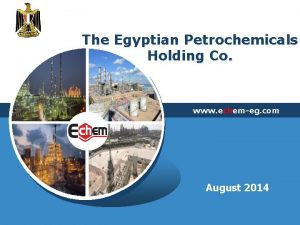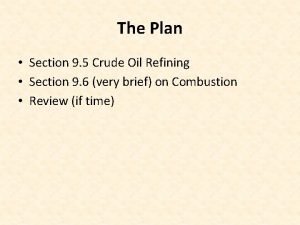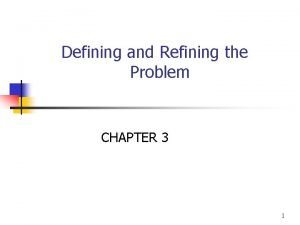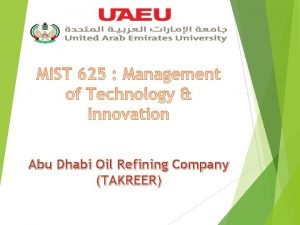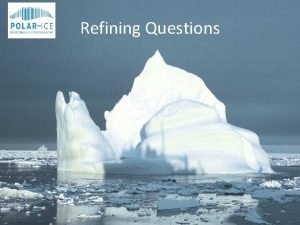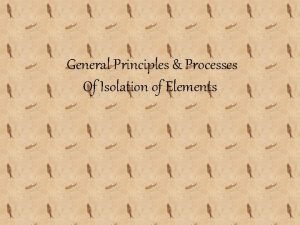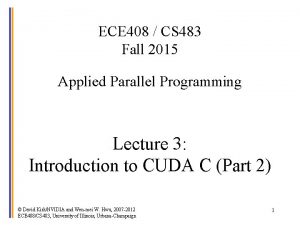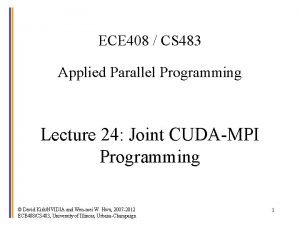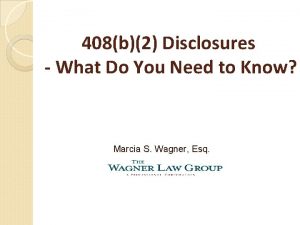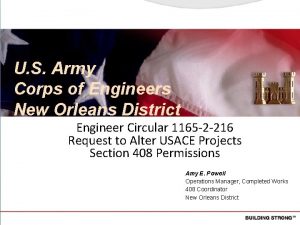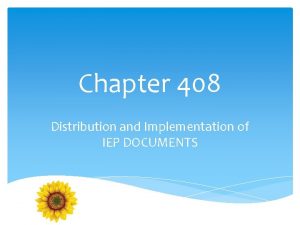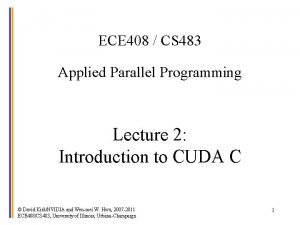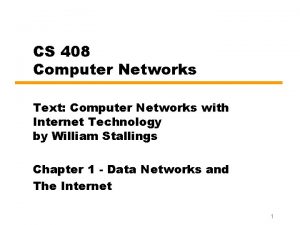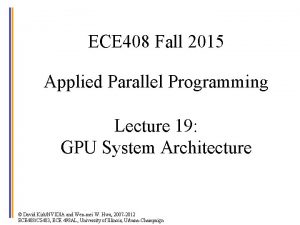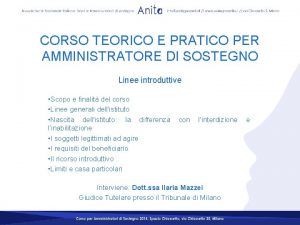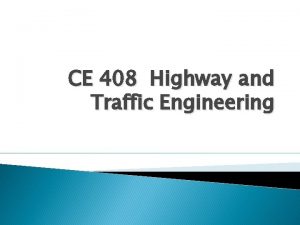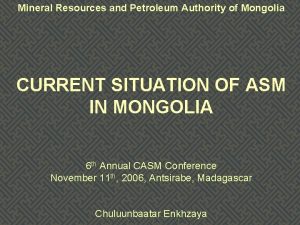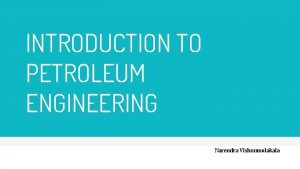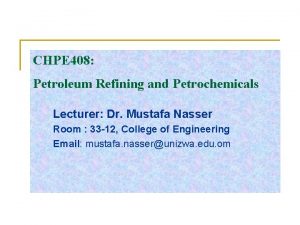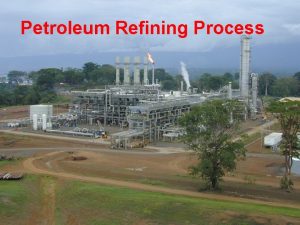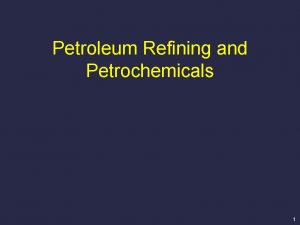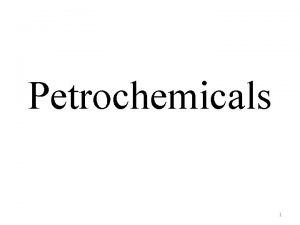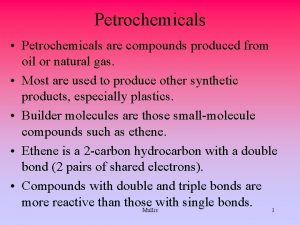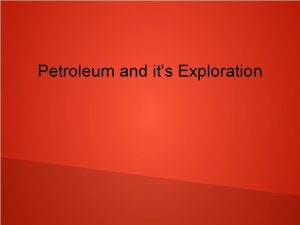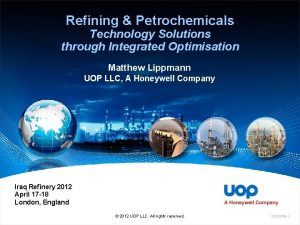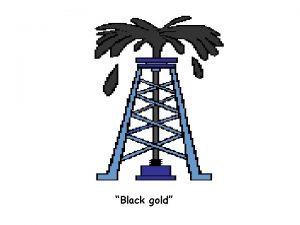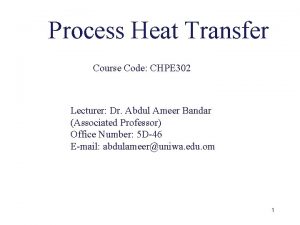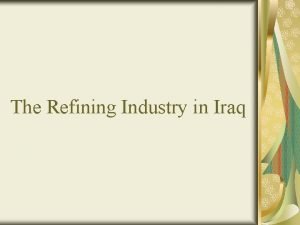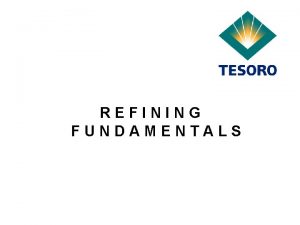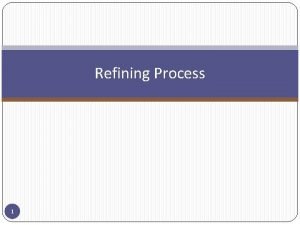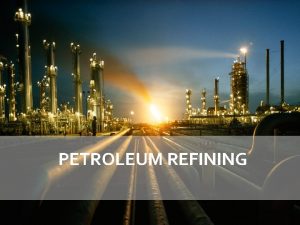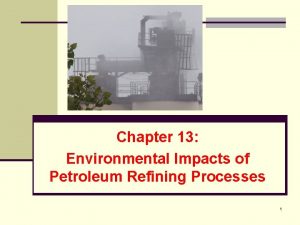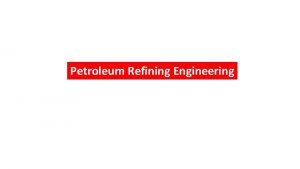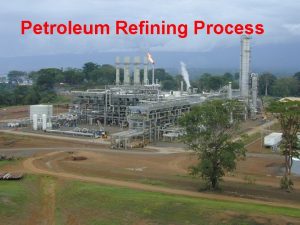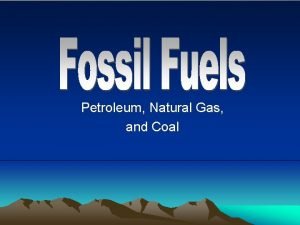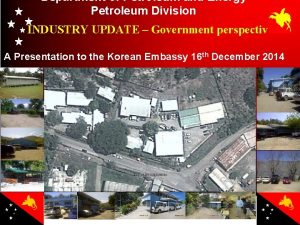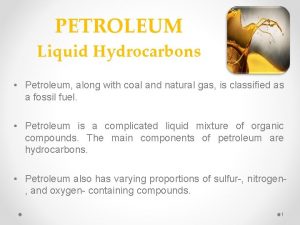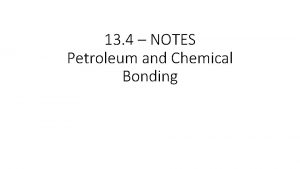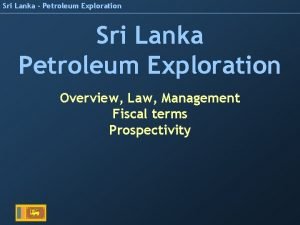CHPE 408 Petroleum Refining and Petrochemicals Lecturer Dr







































- Slides: 39

CHPE 408: Petroleum Refining and Petrochemicals Lecturer: Dr Mustafa Nasser Office : 5 D-444, College of Engineering Email: mustafa. nasser@unizwa. edu. om 1

Course Objectives This course highlights the role of an oil refinery in converting crude oil physically and chemically into useful everyday products like petrol, diesel, lubricating oil, fuel oil and bitumen. 2

Course Learning Outcomes Successful students in this course can: n Understand fundamental technology behind the modern refinery of petroleum n Analyse the role of a chemical engineer in the petroleum processing industry n Use theory learned in this unit for design of petroleum processing plants n Plan and carry out logistics, economical and environmental matters in refineries to achieve optimisation. 3

References n n Speight, J. G. , The Chemistry and Technology of Petroleum, Marcel Dekker Inc. , Third Edition, 1999. ISBN 0 -8247 -0217 -4. Jones, D. S. J. , Elements of Petroleum Processing, John Wiley, 1995. ISBN 0 -47195254 -0. Mc. Ketta, J. J. , Petroleum Processing Handbook, Marcel Dekker Inc. , 1992. ISBN 08247 -8681 -5. Online resources. 4

Assessments Projects and Quizzes: Mid term One: Mid term Two: Final exam: (30%) (15%) (40%) 5

Projects Format Students required to submit the hard copy of their projects. The hard copy should not exceed 10 pages A 4 size, including front page, appendices, etc. ). The text should be made in 12 pt font using Times New Roman style with 1. 5 line spacing. References should be written in standard scientific way (check the literature). A direct copy of the work of others (including Internet resources) will be considered plagiarism. 6

Plagiarism Policy As per the University Policy Uo. N-STC-CR-1 -2009, the following actions(not limited to), without proper attribution (quoting and/or referencing), will attract stringent penalties: 1. copy the work of another student; 2. directly copy any part of another person’s work; 3. summaries another person’s work; 4. use or develop an idea or thesis derived from another person’s work; or 5. use experimental results or data obtained or gathers by another person. 6. cheating during exam 7

Attendance Policy As per the University Absentee Regulations Uon-RR-AP-12009, Absentee warning notice will be issued to the student according to: 1. “Absentee Warning 1” has to be issued to student who has missed 5% of course contact hours (~ 2 lectures). 2. “Absentee Warning 2” has to be issued to student who has missed 10% of course contact hours. 3. “Drop one Grade” has to be issued to student who has missed 15% of course contact hours. 4. “Barred from Examination” has to be issued to student who has missed 25% of course contact hours. 8

Project Reviewing Procedure After project submission, all students are required to present their work in the class. A peer review practice will be applied to all presentations. Presentation will carry some significant percentage of the final project mark. Students who did not present their work on the specified date and time will get zero in the presentation section, which might be up to 50% of the overall project mark. 9

What is Petroleum? n n This name, meaning rock oil, is applied to certain bituminous fluids found in the earth. Solid bitumen, or asphalt, differs but little in chemical composition from petroleum, both being compounds of carbon and hydrogen. Petroleum has probably been formed by a slow decomposition of organic matters under the earth's surface, a so-called fossil fuel. Crude oils vary in color, from clear to tar-black, and in viscosity, from that of water to almost similar to solid viscosities. 10

Theory of Petroleum Origin n Over time the landscape changed and this assembly of un-decomposed materials formed sediment and was buried in the ground, finally reaching a depth where the pressure and heat was sufficient to transform it into a material with high energy density and wide usability, crude oil. n The interval of depth where crude oil can be formed is called the oil-window and is related to the earth's temperature. The oil-window is between 60 and 150 C, which correspond to a depth of about 2 to 6 kilometers, with a global average geothermal gradient of 2. 6 C/ 100 m. If the temperature is too high natural gas is developed. The accumulation of material mainly happened during two periods of time, 100 and 150 million years ago. 11

Oil Well n n n The details of the origin of crude oil are not fully understood but it is clear that it is a none-renewable and a limited source of energy. In mining for it, a well 3 or 4 inches in diameter, and sometimes 700 or 800 feet deep, is bored by drills, generally by steam-power. When rock containing petroleum is being bored through, what called "a show of oil" is found. 12

Crud Oil Properties n n n Petroleum is a very complex collection of compounds. The liquid part of petroleum is called crude oil. The colour of crude oil goes from almost colorless to black and the viscosity, at room temperature, varies from easy flowing to almost solid. The composition of crude oil does not only vary between different fields, it is also likely to vary by depth and between different wells in the same field. 13

Chemical Composition of Crude Oil n crude oil can be divided into three groups, which are q q q n paraffins, Napthenes (cycloalkanes) and aromatics. It is commercially divided into two kinds, q q the heavy, or lubricating oil, and the light oil. 14

Types of Crude n n n Major Type Based on Geography q Far Eastern q Middle Eastern q North Sea q Others The formation conditions - never identical. Known crudes > 100 Countries producing crude > 48 Most important area for crude – Middle East Saudi Arabia - 26% world reserve 15

Crude Oil Reserves 16

Crude Oil: Physical Characteristics Colour: Dark Red, Brown, Black, etc. Viscosity: From As Fluid As Water to Tar-Like Odour: From Nil to Rotten Eggs Pour Point: 0 deg F to 100 deg F Density: 0. 8 - 1. 0 g/cc 17

Crude Oil Chemical Composition Crude oils are made of the following elements/ compounds: n Carbon n Hydrogen n Sulfur – found in hydrogen sulfide, sulfides, disulfides, elemental sulfur n Nitrogen – found in basic compounds with amine groups n Oxygen - found in organic compounds such as carbon dioxide, phenols, ketones, carboxylic acids n Metals – mainly nickel, iron, vanadium, copper, arsenic n Salts – such as sodium chloride, magnesium chloride, calcium chloride 18

Composition of Typical Petroleum Samples Element Natural gas/weight% Crude oil/weight% Bitumen/weight% carbon 65. 0– 80. 0 85. 0 80. 2 hydrogen 20. 0– 25. 0 12. 0 7. 5 oxygen trace >2. 0 7. 6 nitrogen 1. 0– 15. 0 >1. 5 1. 7 sulfur >0. 2 >3. 0 19

Crude Oil Chemical Composition Hydrocarbon n q q n Collection of carbon and hydrogen molecules C 1 to C 360 in Different Molecular Structure Major classes/ “families” in crude oil: q Paraffins q Naphthenes q Aromatics 20

Refinery n Organised and coordinated arrangement of manufacturing process to provide physical & chemical change of crude oil 21

22

23

24

25

26

Petroleum Products n There are specifications for over than 2000 refinery products 27

Petroleum Products 28

Crude Oil Assay n A Crude assay is a sheet summarizing the properties of a particular crude, including: q q q q Distillation Range Specific Gravity (Density) Sulfur Content Pour Point Carbon Residue Nitrogen Content Metal Content 29

Ultimate Crude Oil Analysis Ultimate crude oil analysis describes the composition as a percentage of carbon, hydrogen, nitrogen, oxygen, and sulfur. Also, a chemical analysis is performed which describes the composition as a percentage of paraffinic-, naphthenic-, and aromatic-type compounds. 30

Fractional Distillation Fractional distillation characterizes the initial boiling point, volume % of materials boiling at specified temperature ranges, end point, residue, and loss. A procedure termed 15: 5 distillation is frequently used to assist in crude oil characterization. This procedure utilizes a column possessing the equivalent of 15 theoretical plates and a reflux ratio of 5: 1. 31

Gravity Both American Petroleum Institute degrees (0 API) and specific gravity (SG) provide information on the paraffinic or aromatic nature of crude. The API gravity of most crude oil falls between the range of 200 API to 450 API. API (American Petroleum Institute) is a trade association, which is engaged in all aspects of the U. S. petroleum industry including producers, refiners, marketers, and transporters. 32

Sulfur Content High-sulfur crudes, especially those with a sulfur content >0. 5 wt%, complicate refining and are also more expensive to refine. Sulfur and some sulfur compounds are corrosive toward metals and can decrease the p. H of the crude oil. The sulfur content of most crude oil varies from <0. 1% to >5%. The terms "sweet" and "sour" are often used to characterize crude oils. These terms were originally coined to identify the characteristic hydrogen sulfide odor of the crude oil. They are now commonly used to distinguish the crude oil sulfur level. In general, those crudes containing approximately 0. 5 wt% sulfur or less are considered sweet, and those containing greater than 0. 5 wt% sulfur are considered "sour. " 33

Nitrogen Content Nitrogen is a severe refining catalyst poison. Crude oils containing >0. 25 wt% nitrogen are difficult to refine. 34

Salt Content Salts can foul refining equipment. Under refining conditions, salts can break down to liberate acids during processing. If salt content of crude oil is greater than 30 part per million (ppm), the crude oil must be desalted before processing. 35

Water and Salts Water and salts can lead to major problems such as equipment corrosion, uneven heating, and equipment fouling. 36

Viscosity and Pour Point The viscosity of a crude oil is a measure of its internal resistance to flow. The higher the viscosity of crude oil, the more difficult to flow. The pour point of a crude oil is the lowest temperature at which it will flow under prescribed conditions. The pour point of the crude oil is a rough indicator of the relative paraffinicity and aromaticity of the crude. The lower the pour point, the lower the paraffin content and the greater the content of aromatics. 37

Metals The metal content can range from only a few ppm to >1000 ppm. Trace elements such as iron, sodium, nickel, vanadium, lead, and arsenic can corrode metallic parts and damage heating equipment. Low levels of nickel, vanadium, and copper are known to deactivate refining catalysts. 38

End of Chapter One 39
 Lecturer's name or lecturer name
Lecturer's name or lecturer name Egyptian petrochemicals holding company
Egyptian petrochemicals holding company Mnemonic for fractional distillation of crude oil
Mnemonic for fractional distillation of crude oil Petrochemicals
Petrochemicals Cpq petrochemicals industry
Cpq petrochemicals industry Broad problem area examples
Broad problem area examples Abu dhabi oil refining company takreer
Abu dhabi oil refining company takreer Refining discussion techniques
Refining discussion techniques Short note on vapour phase refining
Short note on vapour phase refining Jeannie watkins
Jeannie watkins Spe distinguished lecturer
Spe distinguished lecturer Good afternoon teachers
Good afternoon teachers Photography lecturer
Photography lecturer Lecturer in charge
Lecturer in charge Designation lecturer
Designation lecturer Designation of lecturer
Designation of lecturer Guest lecturer in geography
Guest lecturer in geography Lecturer name
Lecturer name Pearson lecturer resources
Pearson lecturer resources Spe distinguished lecturer
Spe distinguished lecturer Lector vs lecturer
Lector vs lecturer Lecturer in charge
Lecturer in charge Cfa lecturer handbook
Cfa lecturer handbook Lecturer asad ali
Lecturer asad ali Cs483 uiuc
Cs483 uiuc Cs 483
Cs 483 Cse 408
Cse 408 408(b)(2) checklist
408(b)(2) checklist Usace section 408
Usace section 408 Chapter 408
Chapter 408 Ece 408
Ece 408 Cs 408 sabancı
Cs 408 sabancı Pub 408
Pub 408 Ece 408
Ece 408 Ece 408
Ece 408 Amministratore di sostegno lite tra fratelli
Amministratore di sostegno lite tra fratelli Map study in highway engineering
Map study in highway engineering Statoil ministry of petroleum and energy
Statoil ministry of petroleum and energy Mineral resources and petroleum authority of mongolia
Mineral resources and petroleum authority of mongolia Petroleum engineering pros and cons
Petroleum engineering pros and cons

